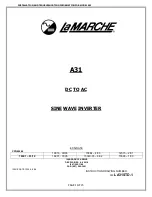
V - Hardware Configuration
5.1 Dip Switches
5.2 Control Port Configuration
6.0 Glossary
7.0 Troubleshooting
X.0 Glossary
The list of terms below are often found in RDS/RBDS documentation. Frequently they are not
detailed, and it is assumed the reader is familiar with their meanings. The explanations given
are for guidance and the user should consult the RDS/RBDS Standards for a full explanation.
AF
Alternative Frequencies list.
This is an optional list of frequencies which can be used by a broadcaster to tell the
radio alternative frequencies on which the program being broadcast on can be received
on. This enables radios with the memory feature to more quickly switch to another
stronger signal when required. This feature is especially useful for mobile (car) radios.
AID
Applications Identification for ODA.
The Application Identification code is part of the Open Data Application (ODA)
extensions to the RDS specification. It is used by a receiver to search for a broadcast
station that supports the ODA the receiver is designed for.
CT
Clock Time and date.
The Clock Time and date feature is used as a time stamp by a number of applications,
it should be accurately maintained at all times or disabled. The date should be in
Modified Julian Day (MJD) format, and the time should be in Universal Time
Coordinated (UTC) format. The receiver is responsible for converting this into the
appropriate local format.
DI Decoder
Identification.
These flags indicate which receiver mode of operation is appropriate for the type of
audio broadcast.
ECC Extended Country Code.
The Radio Data System (RDS) has its own series of country codes encoded in the
most significant bits of the Program Identification (PI) code. As there are only 4 bits
available for this in the PI code, there needs to be an extended code to give correct
country identification. The ECC code is eight bits long and when used with the 4 bits
in the PI code give an accurate country/region indication.
29
Summary of Contents for rds2
Page 42: ...www bwbroadcast com...













































